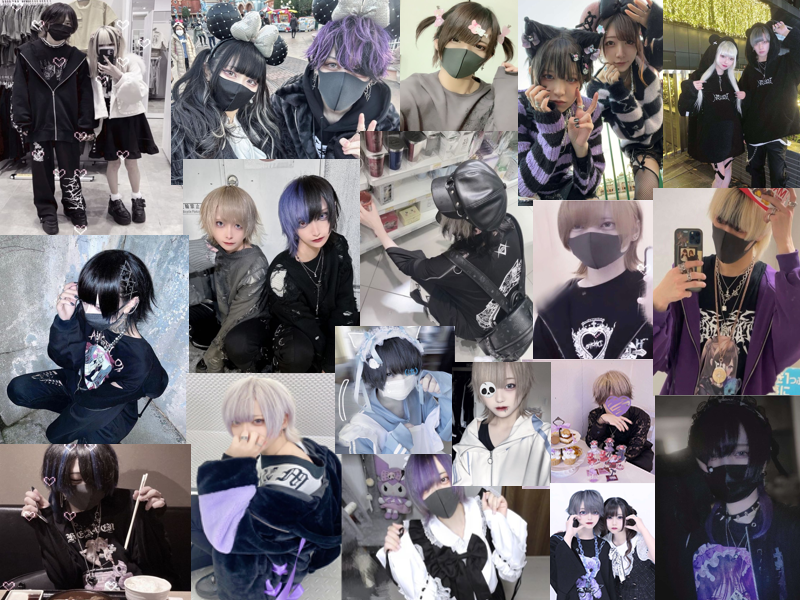Unveiling Jirai Kei: The Darkly Girly Japanese Fashion Style Explained
Is fashion a mirror reflecting society, or a catalyst for change? In the heart of Japan, a subculture known as Jirai Kei is challenging conventional norms and sparking intense debate, as it navigates the complex terrain of self-expression, identity, and the darker facets of the human experience.
Jirai Kei, translating roughly to "landmine style," is a multifaceted subculture originating in Japan. It primarily caters to young women, characterized by a distinctive fashion aesthetic that blends hyperfeminine elements with darker, more edgy undertones. This style isn't merely about clothing; it's a statement, a declaration of a specific mindset and, for some, a coping mechanism.
The core of Jirai Kei fashion revolves around a curated blend of elements. Black and pink form the foundational color palette, frequently accented by shades of lavender and purple. Lace, ruffles, frills, and other details are considered indispensable, creating a deliberately feminine atmosphere. However, this sweetness is often juxtaposed with darker touches, such as platform boots, studded accessories, and graphic tees, signifying a complex and often contradictory personality. The makeup is a crucial component, frequently incorporating heavy eyeliner, blush, and a focus on creating a doll-like appearance. While the clothes are important, the makeup is what really makes the style, making the wearers look like something out of a manga. In essence, it's an aesthetic that seeks to capture the melancholy and the complexities of modern life, a visual representation of the internal struggles many young people face.
The term "Jirai Kei" itself contributes to the controversy. The name, which translates to "landmine style," is a powerful metaphor, hinting at the potential for self-destructive tendencies and emotional volatility associated with the subculture. This association, combined with the fashion's link to mental health struggles and, in some interpretations, aggressive behavior, has led to significant criticism, particularly within Japan. Many find the style to be promoting dangerous behavior. Despite its popularity, its negative association has caused a stir in Japan. However, the subculture's influence continues to spread across the globe, finding audiences interested in its distinctive aesthetic and the complex emotions it embodies.
The world of Jirai Kei is not limited to women; there's also a community of men embracing the style. Known as "Jirai Danshi," these individuals offer a unique perspective on the subculture. While not as widespread as the women's version, Jirai Danshi demonstrates the versatility and appeal of the aesthetic. They often adopt a similar color palette, incorporating black, pink, lavender, and purple into their wardrobes. Oversized shirts, baggy trousers, jackets, and arm warmers are common choices, giving them a distinct, androgynous look. It's a clear signal that this style is not limited to any gender.
While the fashion elements are key, the emotional and psychological undercurrents are central to Jirai Kei. The subculture often serves as a form of self-expression and a way to communicate internal turmoil. Many individuals involved in Jirai Kei have reported using the style to express feelings of anxiety, sadness, or isolation. The makeup and clothing act as a mask, a shield, or a means of projecting a particular image to the world. This aspect, coupled with the association with potentially self-destructive behaviors, makes the subculture a topic of ongoing discussion and debate.
This movement isn't just a local trend; it's spreading through social media and pop culture. Platforms like TikTok and Bilibili are filled with videos demonstrating Jirai Kei fashion, makeup tutorials, and explorations of the subculture's themes. This online presence has broadened the reach, attracting both adult and male audiences, solidifying its status as a relevant cultural phenomenon. This reach has helped make the culture more mainstream. Anime and manga also show it, introducing a wide audience to the aesthetics.
Despite its popularity, the term and the activities associated with it, are controversial, especially in Japan. The very name, "Jirai Kei," is charged with negativity, evoking images of hidden dangers and explosive emotions. The style has been criticised for its potential links to self-harm, mental health issues, and violence. It is seen by critics as glorifying those things. However, the term continues to be used both in Japan and abroad, a testament to the subculture's enduring appeal and the strong community that has formed around it.
The evolution of Jirai Kei reflects the ever-changing nature of fashion, social trends, and the role of self-expression in the digital age. It challenges conventions, pushing boundaries and sparking conversations about identity, mental health, and the societal pressures faced by young people. It is a story of fashion and its ability to both reflect and influence the world around it.
Below is a table presenting a basic guideline to the outfit building for Jirai Kei:
| Element | Description | Examples |
|---|---|---|
| Color Palette | Dominant use of black and pink, often with lavender or purple accents. | Black dresses with pink lace, pink blouses with black skirts, purple hair accessories. |
| Clothing Details | Emphasis on feminine elements like lace, ruffles, frills, and ribbons. | Lace-trimmed tops, ruffled skirts, frilly blouses, and bow-adorned accessories. |
| Outerwear | Jackets, cardigans, or oversized tops, often with edgy details. | Leather jackets, denim jackets with patches, oversized hoodies. |
| Accessories | Bags, shoes, jewelry, and other items that complement the aesthetic. | Platform boots, Mary Janes, heart-shaped bags, chokers, studded belts, and arm warmers. |
| Makeup | Key component, focusing on a doll-like appearance with dramatic elements. | Heavy eyeliner, blush, contouring, and often a focus on the eyes. |



